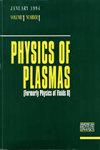研究优化的反应堆级准轴对称恒星器中的非线性磁流体力学
IF 2.2
3区 物理与天体物理
Q3 PHYSICS, FLUIDS & PLASMAS
引用次数: 0
摘要
我们利用扩展磁流体动力学(MHD)代码 M3D-C1 的新模拟功能,研究了反应堆尺度的准对称恒星器平衡的非线性 MHD 特性。我们的模型捕捉了磁场、温度、密度和流动剖面的自洽演化,而不对第一种结构施加限制。我们使用一个与温度相关的现实斯皮策模型,将电阻率的影响包括在内,同时还使用了一个能捕捉关键物理特征的热传输模型,即在垂直于磁场和平行于磁场的方向上的强各向异性扩散。我们考虑了一个准轴对称的有限压力平衡,该平衡针对自洽的引导电流、准对称性和高能粒子约束进行了优化。我们的评估发现,在等离子体边缘附近,该平衡极不稳定,容易发生类似于交换的压力驱动不稳定性。最初不稳定的模式会迅速破坏 N 倍旋转对称性(在本例中为环形)方向上其他模式的稳定。对于这种平衡,N = 2 意味着大量偶数环形傅立叶模式失稳。因此,场周期性可能是优化恒星器非线性 MHD 稳定特性的一个重要因素。本文章由计算机程序翻译,如有差异,请以英文原文为准。
Investigating nonlinear magnetohydrodynamics in an optimized, reactor-scale quasi-axisymmetric stellarator
We use the new simulation capabilities of the extended-magnetohydrodynamic (MHD) code, M3D-C1, to investigate the nonlinear MHD properties of a reactor-scale quasisymmetric stellarator equilibrium. Our model captures the self-consistent evolution of the magnetic field, temperature, density, and flow profiles without imposing restrictions on the structure of the first. We include the effects of resistivity using a realistic temperature-dependent Spitzer model, along with a model for heat transport that captures the key physical characteristic, namely, strongly anisotropic diffusion in directions perpendicular and parallel to the magnetic field. We consider a quasi-axisymmetric, finite-pressure equilibrium that was optimized for self-consistent bootstrap current, quasi-symmetry, and energetic particle confinement. Our assessment finds that the equilibrium is highly unstable to interchange-like pressure-driven instabilities near the plasma edge. The initially unstable modes rapidly destabilize other modes in the direction of the N-fold rotational symmetry (toroidal, in this case). For this equilibrium, N = 2, meaning destabilization of a large number of even-numbered toroidal Fourier modes. Thus, field-periodicity is likely to be an important factor in the nonlinear MHD stability characteristics of optimized stellarators.
求助全文
通过发布文献求助,成功后即可免费获取论文全文。
去求助
来源期刊

Physics of Plasmas
物理-物理:流体与等离子体
CiteScore
4.10
自引率
22.70%
发文量
653
审稿时长
2.5 months
期刊介绍:
Physics of Plasmas (PoP), published by AIP Publishing in cooperation with the APS Division of Plasma Physics, is committed to the publication of original research in all areas of experimental and theoretical plasma physics. PoP publishes comprehensive and in-depth review manuscripts covering important areas of study and Special Topics highlighting new and cutting-edge developments in plasma physics. Every year a special issue publishes the invited and review papers from the most recent meeting of the APS Division of Plasma Physics. PoP covers a broad range of important research in this dynamic field, including:
-Basic plasma phenomena, waves, instabilities
-Nonlinear phenomena, turbulence, transport
-Magnetically confined plasmas, heating, confinement
-Inertially confined plasmas, high-energy density plasma science, warm dense matter
-Ionospheric, solar-system, and astrophysical plasmas
-Lasers, particle beams, accelerators, radiation generation
-Radiation emission, absorption, and transport
-Low-temperature plasmas, plasma applications, plasma sources, sheaths
-Dusty plasmas
 求助内容:
求助内容: 应助结果提醒方式:
应助结果提醒方式:


